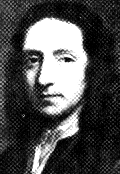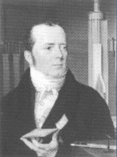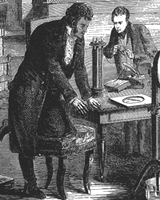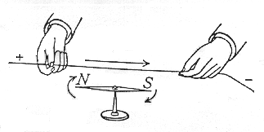#2H. Magnetic Fields -- History
Until 1821, the only magnetism known was that of iron magnets
and of "lodestones", natural magnets of iron-rich ore.
|
It was believed that the inside of the Earth was magnetized in the same fashion, and scientists were greatly puzzled when they found that the direction of the compass needle at any place slowly shifted, decade by decade, suggesting a slow variation of the Earth's magnetic field.
How can an iron magnet produce such changes? Edmond Halley (of comet fame) ingeniously proposed that the Earth contained a number of spherical shells, one inside the other, each magnetized differently, each slowly rotating in relation to the others.
|  Edmond Halley Edmond Halley
|
 Hans Christian Oersted Hans Christian Oersted
| Hans Christian Oersted was a professor of science at Copenhagen University. In 1821 he arranged in his home a science demonstration to friends and students. He planned to demonstrate the heating of a wire by an electric current, and also to carry out demonstrations of magnetism, for which he provided a compass needle mounted on a wooden stand.
|
|
While performing his electric demonstration, Oersted noted to his surprise that every time the electric current was switched on, the compass needle moved. He kept quiet and finished the demonstrations, but in the months that followed worked hard trying to make sense out of the new phenomenon.
|  Oersted's Experiment Oersted's Experiment
|
 What Oersted saw... What Oersted saw...
| But he couldn't! The needle was neither attracted to the wire nor repelled from it. Instead, it tended to stand at right angles (see drawing below). In the end he published his findings (in Latin!) without any explanation.
|
|
Andre-Marie Ampere in France felt that if a current in a wire exerted a magnetic force on a compass needle, two such wires also should interact magnetically. In a series of ingenious experiments he showed that this interaction was simple and fundamental--parallel (straight) currents attract, anti-parallel currents repel, and the force is inversely proportional to the square of the distance between the wires.
|
|
There thus existed two kinds of forces associated with electricity--electric and magnetic. In 1864 James Clerk Maxwell demonstrated a subtle connection between the two types of force, unexpectedly involving the velocity of light. From this connection sprang the idea that light was an electric phenomenon, the discovery of radio waves, the theory of relativity and a great deal of present-day physics.
|  Maxwell Maxwell
|
Futher reading:
--look up in an encyclopaedia "Halley, Edmond", "Oersted, Hans Christian", "Ampere, Andre-Marie" and "Maxwell, James Clerk."
--"From Falling Bodies to Radio Waves" by Emilio Segre, W.H. Freeman and Co., 1984, gives a very good account of the history of electricity and magnetism (and of physics up to 1895). Segre, who won the Nobel prize in physics, wrote in a clear style with many insights and anecdotes about the discoveries which laid the foundations of physics.
--"Oersted and the Discovery of Electromagnetism" by Bern Dibner (Blaisdell Publ. Co., 1962), a slim book with details about Oersted and his time.
--"Andre-Marie Ampere" by L.Pearce Williams, Scientific American January 1989, p. 90.
--"Edmond Halley, Geophysicist" by Michael E. Evans, Physics Today, February 1988, p. 41-45.
"Exploration" home page (index)
Glossary
Next Stop: #3. The Polar Aurora
 Official GSFC Home Page .........
Official GSFC Home Page .........
 NASA WWW Home Page
NASA WWW Home Page
Authors and Curators:
- David P. Stern - NASA/GSFC Code 695 (u5dps@lepvax.gsfc.nasa.gov)
- Mauricio Peredo - Raytheon STX Corporation (peredo@istp1.gsfc.nasa.gov)
Last updated March 13, 1999
 Edmond Halley
Edmond Halley Hans Christian Oersted
Hans Christian Oersted Oersted's Experiment
Oersted's Experiment What Oersted saw...
What Oersted saw... Maxwell
Maxwell Official GSFC Home Page
Official GSFC Home Page  NASA WWW Home Page
NASA WWW Home Page